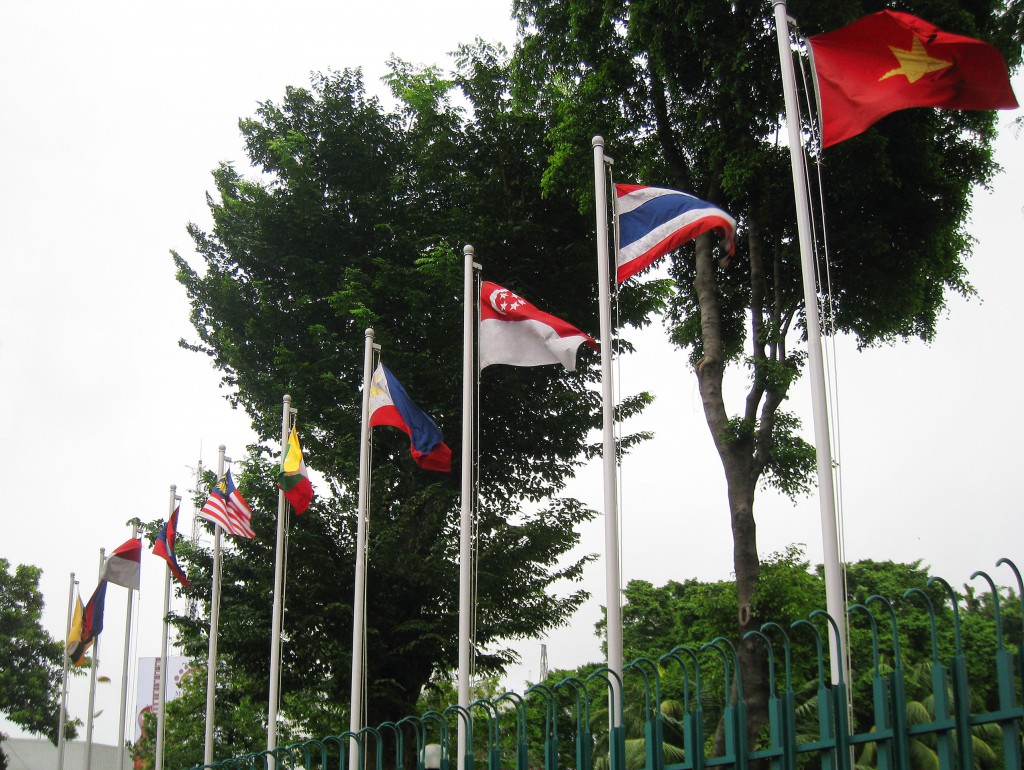 Southeast Asia is feeling the pressure from Asia’s big beasts.
Southeast Asia is feeling the pressure from Asia’s big beasts.
ASEAN, as a middle-power grouping, might be glad of a bit of extra middle-power heft from the likes of Australia and New Zealand.
The strategic case for ASEAN taking its partnership with Australia and New Zealand to higher levels was one element of my discussion with the former ASEAN Secretary-General, Ong Keng Yong.
The previous post reported Ong’s thoughts on my argument for Australia and New Zealand to become members of ASEAN.
A new ASEAN status for Australia and New Zealand, he says, would offer geopolitical benefits for ASEAN that might outweigh the standing geographic veto over ASEAN membership for anyone outside Southeast Asia.
Ong: Right now the ASEAN countries as a group, increasingly we can feel we are being squeezed between China, Japan and India. One thing good about the Americans is that they are so benign as a big power, vis-a-vis Southeast Asia. We never really got serious pressure from them. Once in a blue moon we got a hammering by them on human rights issues and lately, people smuggling. But overall, they come across as a very benign strategic power which we in Southeast Asia—even our friends on mainland Southeast Asia would admit it—we like having the Americans around. They bring in business, investment, a new way of looking at the world. We leave the big, big politics to them, working with the Chinese and the Indians and the Japanese.
Lately because of the South China Sea issue, it’s starkly displayed what it would be like if we, ASEAN, have to deal with this by ourselves. It is not easy. Continental Southeast Asia is very much sensitive to what the big brother [China] wants. But maritime Southeast Asia—Malaysia, Singapore, Indonesia, Philippines and Brunei—go, ‘Oh, dear!’ That’s why the stress now is on always on multilateralism and inclusive, open-ended development.
So, conceivably as our ASEAN business and trade and other relations grow with Australia and New Zealand in the next ten or 15 years, there will be more of a balance. The geography of Southeast Asia will not be just the ten, eleven Southeast Asians nations, not just ASEAN as an organisation. But with Australia and New Zealand as part of the equation. Part of, in Chinese terms, part of the equation.
Dobell: Bulking up ASEAN as the middle power grouping by bringing in a couple of more middle powers?
Ong: Yes, we are also geographically somewhere in the middle. I assume the Indian Ocean will be very much India and South Asia; northern Pacific will be China, Japan and Korea. And until now, the southern part of the Western Pacific is Australia and New Zealand. No issue. So if it goes on in this current trajectory with everybody trying to grab what they can, establish their sphere of influence. We in ASEAN will go back to our [1967] Bangkok Declaration and say, ‘Hey, we are not interested in your sphere of influence or your reshaping of the regional order.’ We just want to be ASEAN and whoever works with us. And in this respect, Australia and New Zealand will be a major factor; because we grow our trade—China, yes, we grow our trade; Japan, we grow our trade—
but in terms of the people exchange, the development of the next generation of professionals, it’s quite different. Because more Southeast Asians come to study in Australia, they spend years in Australia.
As the previous post outlined, Ong’s thinking on integrating Australia and New Zealand with ASEAN centres on the term ‘partnership’ not ‘membership.’
The former ASEAN Secretary-General dismisses my idea that Australia and New Zealand get half-in status in ASEAN by becoming Observers. Ong sees this as too compliant with ASEAN forms, while simultaneously not delivering real substance or conferring much membership status.
Instead, sidestep the opposition to anyone beyond Southeast Asia being an ASEAN member by creating a new form of quasi-membership for Australia and New Zealand. A bigger and better and more intimate Oz–Kiwi relationship with ASEAN—but what to call it?
Ong: I don’t think we ought to use the term ‘associate’—we don’t like the word ‘associate.’ We don’t like the word ‘membership’ per se, because we say it’s only ASEAN 10—and now the big debate is about Timor Leste. So I think it will be more driven by the concept of partnership, moving from Dialogue partnership to what? You’re the wordsmith—you can invent something!
Dobell: That’s why I chickened out and just took the Observer model—but supercharge it so it describes a different ASEAN relationship with Australia and New Zealand, different to what you have with Papua New Guinea and Timor Leste. Because at least Observer is an existing basis.
Ong: It’s an interesting concept. People can understand it. But I don’t know. I think it may not work that way. It may not be useful to have that existing vocabulary. Because it doesn’t project the new century relationship between Australia, New Zealand and Southeast Asia.
A little un-ASEAN, this. Ditch the existing vocabulary. Do something new. Express the 21st Century relationship with a fresh relationship category.
Australia and New Zealand need to reach for a partnership that goes well beyond dialogue to become part of ASEAN’s creation of Community.
It’s a classic ASEAN fix: give Australia and New Zealand membership rights but call it some form of super partnership.
Exercising my Ong-conferred status as wordsmith, the label I came up with would emphasise an embrace of Community equal to the embrace of ASEAN.
How do you like the sound of Australia and New Zealand as ASEAN Community Partners?

